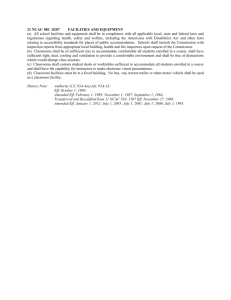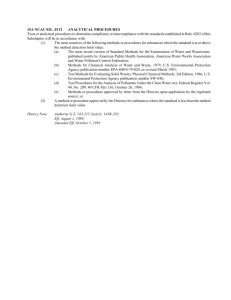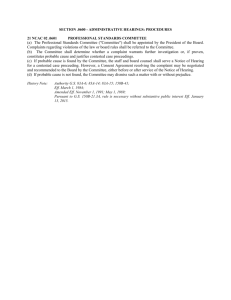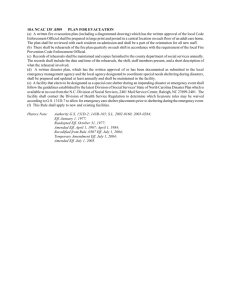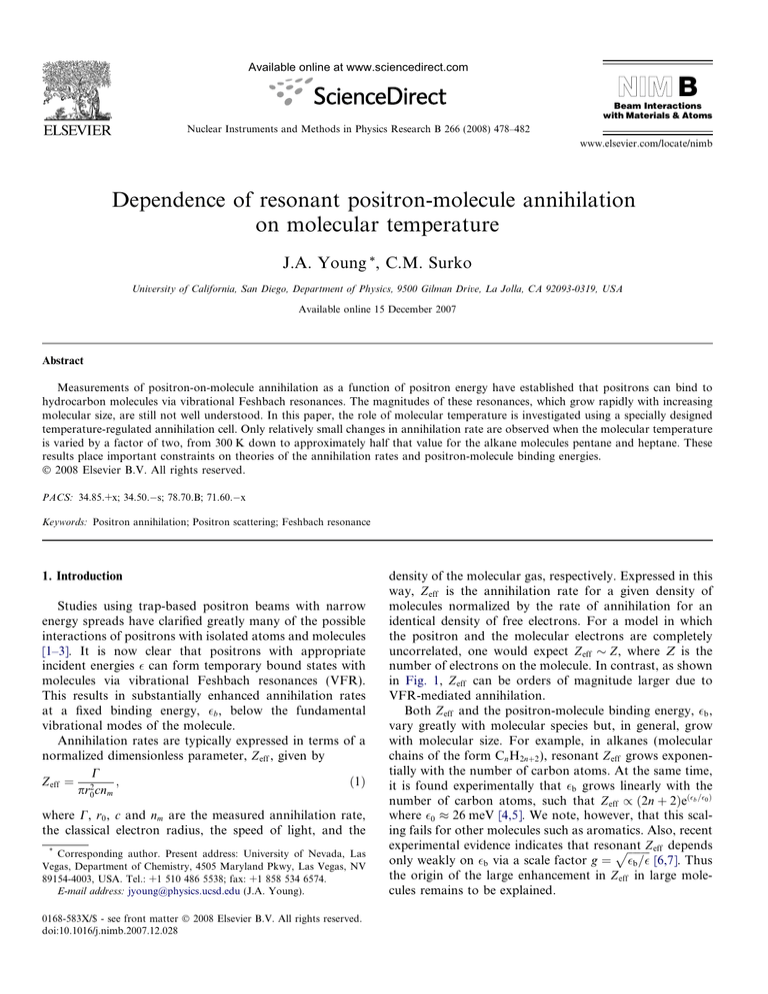
Available online at www.sciencedirect.com
NIM B
Beam Interactions
with Materials & Atoms
Nuclear Instruments and Methods in Physics Research B 266 (2008) 478–482
www.elsevier.com/locate/nimb
Dependence of resonant positron-molecule annihilation
on molecular temperature
J.A. Young *, C.M. Surko
University of California, San Diego, Department of Physics, 9500 Gilman Drive, La Jolla, CA 92093-0319, USA
Available online 15 December 2007
Abstract
Measurements of positron-on-molecule annihilation as a function of positron energy have established that positrons can bind to
hydrocarbon molecules via vibrational Feshbach resonances. The magnitudes of these resonances, which grow rapidly with increasing
molecular size, are still not well understood. In this paper, the role of molecular temperature is investigated using a specially designed
temperature-regulated annihilation cell. Only relatively small changes in annihilation rate are observed when the molecular temperature
is varied by a factor of two, from 300 K down to approximately half that value for the alkane molecules pentane and heptane. These
results place important constraints on theories of the annihilation rates and positron-molecule binding energies.
Ó 2008 Elsevier B.V. All rights reserved.
PACS: 34.85.+x; 34.50.s; 78.70.B; 71.60.x
Keywords: Positron annihilation; Positron scattering; Feshbach resonance
1. Introduction
Studies using trap-based positron beams with narrow
energy spreads have clarified greatly many of the possible
interactions of positrons with isolated atoms and molecules
[1–3]. It is now clear that positrons with appropriate
incident energies can form temporary bound states with
molecules via vibrational Feshbach resonances (VFR).
This results in substantially enhanced annihilation rates
at a fixed binding energy, b , below the fundamental
vibrational modes of the molecule.
Annihilation rates are typically expressed in terms of a
normalized dimensionless parameter, Z eff , given by
C
Z eff ¼ 2
;
ð1Þ
pr0 cnm
where C, r0 , c and nm are the measured annihilation rate,
the classical electron radius, the speed of light, and the
*
Corresponding author. Present address: University of Nevada, Las
Vegas, Department of Chemistry, 4505 Maryland Pkwy, Las Vegas, NV
89154-4003, USA. Tel.: +1 510 486 5538; fax: +1 858 534 6574.
E-mail address: jyoung@physics.ucsd.edu (J.A. Young).
0168-583X/$ - see front matter Ó 2008 Elsevier B.V. All rights reserved.
doi:10.1016/j.nimb.2007.12.028
density of the molecular gas, respectively. Expressed in this
way, Z eff is the annihilation rate for a given density of
molecules normalized by the rate of annihilation for an
identical density of free electrons. For a model in which
the positron and the molecular electrons are completely
uncorrelated, one would expect Z eff Z, where Z is the
number of electrons on the molecule. In contrast, as shown
in Fig. 1, Z eff can be orders of magnitude larger due to
VFR-mediated annihilation.
Both Z eff and the positron-molecule binding energy, b ,
vary greatly with molecular species but, in general, grow
with molecular size. For example, in alkanes (molecular
chains of the form Cn H2nþ2 ), resonant Z eff grows exponentially with the number of carbon atoms. At the same time,
it is found experimentally that b grows linearly with the
number of carbon atoms, such that Z eff / ð2n þ 2Þeðb =0 Þ
where 0 26 meV [4,5]. We note, however, that this scaling fails for other molecules such as aromatics. Also, recent
experimental evidence indicates that resonant
pffiffiffiffiffiffiffiffiZffi eff depends
only weakly on b via a scale factor g ¼ b = [6,7]. Thus
the origin of the large enhancement in Z eff in large molecules remains to be explained.
J.A. Young, C.M. Surko / Nucl. Instr. and Meth. in Phys. Res. B 266 (2008) 478–482
479
ular temperature, and so lowering the temperature of the
target gas should result in a dramatic increase in Z eff .
To test these ideas, we performed experiments on two
alkane molecules, pentane ðC5 H12 Þ and heptane ðC7 H16 Þ,
using a specially constructed cold cell designed to measure
the magnitude and energy spectrum of Z eff for test-gas temperatures between 300 K and approximately half that
value. In contrast to the possibilities described above, the
data show a relatively modest temperature dependence
over this range. These results place important constraints
on theoretical models of VFR-enhanced annihilation.
2. Experiment
Fig. 1. Z eff spectrum (d) for butane (C4 H10 ) as a function of positron
energy, , from [4]. The solid curve (–) shows the fundamental vibrational
modes of butane, convolved with a 25 meV Lorenzian function and scaled
arbitrarily. The vertical dashed line indicates the position of the C–H
stretch mode. Note that the Z eff peaks are shifted by an amount b 35 meV below the vibrational mode peaks.
According to a successful theory of VFR-enhanced
annihilation [8,9], for positrons with incident energy, ,
the magnitudes of the Z eff resonances are proportional to
the density of accessible molecular vibrational states,
qð þ b Þ; the positron capture (and emission) rate, CðeÞ ;
and the annihilation rate in a particular state, CðaÞ , normalized by the rate of all possible post-capture processes,
namely,
Z eff ðÞ / qð þ b Þ
CðeÞ CðaÞ
;
CðeÞ þ CðaÞ þ CðoÞ
ð2Þ
where C(o) is the total rate due to inelastic escape channels.
Thus, the normalized rate, Z eff , is reduced if the bound positron is allowed to escape via these additional inelastic
channels. That said, as the binding energy increases, fewer
inelastic channels have sufficient energy to unbind the positron before annihilation.
In principle, thermally excited modes can also stimulate
positron detachment, contributing to the overall inelastic
width described above. In the simplest picture, the probability that a given degree of freedom has sufficient energy
to unbind the positron decreases exponentially with binding energy at a rate proportional to the Boltzmann factor,
expðb =k B T Þ, where k B is the Boltzmann constant and T is
the temperature. As T decreases, so does the probability of
thermal detachment, resulting in an increase in Z eff determined by the binding energy and the mode density.
In this paper, we seek to determine the relative influence
of thermally excited modes on positron binding and Z eff .
One further motivation is to explore the close correspondence between the empirical scaling in alkanes,
Z eff að2n þ 2Þeðb =0 Þ and the reciprocal of the Boltzmann
factor. If this relationship were valid, resonant values of
Z eff in alkanes would be entirely determined by the molec-
The experimental apparatus and procedures for measuring Z eff as a function of positron impact energy at 300 K
are described in detail elsewhere [2,4,10]. In brief, positrons
from a 50 mCi 22Na source are moderated by a solid neon
moderator and guided by a magnetic field into a three-stage,
Penning–Malmberg, buffer-gas accumulator. The positrons
are trapped via inelastic collisions with N2 molecules and
cooled to room temperature via collisions using a gas mixture of N2 and CF4 . Cold, energy-tunable pulses of positrons are then guided magnetically into a cell filled with the
test-gas. The electrical potential on a cylindrical electrode
in the cell sets the positron energy in the interaction region.
The cell is baffled at both ends and surrounded outside
the vacuum chamber with lead to shield the detector from
spurious annihilation gamma-rays coming from outside the
cell. Single, 511 keV gamma rays from the two-gamma
annihilation events are detected using a CsI detector. Typically, the baffle immediately after the gas cell, referred to
as the back baffle, has a positive bias to reflect the incident
positrons, so that the positron pulses may pass through the
gas cell multiple times within a predetermined time window. Absolute values of Z eff are determined using measurements of the positron pulse strength, positron energy, path
length and the test-gas pressure.
The cold cell apparatus, which is shown schematically in
Fig. 2, functions in a manner similar to the 300 K cell used
Fig. 2. Schematic diagram of the cold cell apparatus (not to scale). For
reference, the length of the gas cell mesh is 27 cm.
480
J.A. Young, C.M. Surko / Nucl. Instr. and Meth. in Phys. Res. B 266 (2008) 478–482
in previous measurements, with the exception that it has
been redesigned to allow for controlled cooling and temperature measurements. The previous gas cell and back
electrode were replaced by electrically isolated, gold-plated
copper meshes inside a copper ‘‘cold shell”. The meshes are
used to set the electrical potential inside the gas cell, while
the conduction-cooled, baffled shell contains and cools the
test-gas. The cold shell is designed to freeze out large impurity molecules in the vacuum system and thus keep the
meshes relatively clean. The cold shell rests on stainlesssteel standoffs to thermally isolate it from the vacuum
chamber and is connected by a copper bar to a thermally
insulated vacuum feed through. The feed through is connected to an open-ended heat exchanger outside the vacuum chamber that operates on pulses of liquid N2 from a
supply dewar and exhausts into the atmosphere.
The test-gas cell can be cooled to 100 K with a 10–
15 K variation from one end of the cell to the other. The
temperature is measured by a diode on each side of the cold
shell and a platinum resistive temperature device (RTD) on
the outside of the feed through. The RTD and a proportional-integral-differential controller are used to switch on
and off the flow of liquid N2 to maintain a constant (i.e.
set-point) temperature.
One of the most important constraints in this experiment
is the operating range of test-gas temperatures. It is limited
by the temperature of liquid N2 at atmospheric pressure
(i.e. 77 K) and the conduction of the copper bar connecting
the heat exchanger to the gas cell. Moreover, it is also limited
by the vapor pressure of the test-gas, which decreases with
temperature and must be kept higher than the operating
pressure in the cell to prevent condensation inside or outside
the gas cell. The operating pressure itself must be maintained
high enough for good signal to noise, but low enough to keep
total scattering low (i.e. below about 15%). Since the vapor
pressures and condensation temperatures of alkanes
decrease with increasing molecular size, so does the minimum operating temperature. This places a significant constraint on studies of larger alkane molecules.
The pressure of the test-gas is measured both by a
manometer, connected via a tube to one end of the gas cell
and by an ion gauge near the gas inlet outside the back baffle. The manometer provides an absolute measure of the
gas pressure after applying an equal-flux temperature correction, namely
pffiffiffiffiffiffiffiffiffiffiffiffiffiffi
P m ¼ P c T m =T c ;
ð3Þ
where the subscripts m and c refer to the manometer and
gas cell, respectively. While the ion gauge has a gas-dependant correction factor, it has the advantage that it can measure the low operating pressures needed to study alkanes
with large Z eff . This correction factor is determined empirically by comparing manometer and ion gauge readings at
several pressures below the vapor pressure of the test-gas.
Above the test-gas vapor pressure, liquid starts to condense in the cell and the thermal conduit from the heat
exchanger. In this case, the pressure read by the ion gauge
in the warm region grows rapidly, while the manometer
pressure (which measures the pressure inside the cell)
remains relatively constant. In this case, the cold cell is
acting as a cryopump. Observation of this phenomenon
provides evidence that the test gas is, in fact, making a
sufficient number of inelastic collisions to cool to the cell
temperature. In addition, at the cold temperatures for
which data are presented, the test molecules, pentane and
heptane, have an appreciable probability (e.g. P50%) of
sticking on the cold electrodes upon each collision [11–
13]. It is estimated that a large molecule entering the cold
cell will make 50 collisions with the cell walls, over the
course of 5 ms, before exiting the cell. Thus, equilibration
of the nuclear degrees of freedom with the electrode temperature is a good assumption.
3. Results
The cold cell was used to measure Z eff as a function of
temperature for two alkane molecules, pentane (C5 H12 )
and heptane (C7 H16 ). In each case, energy resolved Z eff
spectra were measured at both room temperature and at
a cold temperature below 200 K (adjusted for each test
species so that the equilibrium vapor pressure was a safe
margin above the set test-gas pressure in the cell). Pentane
was measured at 15.5 ltorr and 153 K and heptane at
1.34 ltorr and 195 K. For reference, the‘‘peak desorption
temperature” for these molecules, which is the temperature
at which the surface sticking coefficient goes to zero, is
168 K and 211 K, respectively, on a Cu(1 1 1) surface [13].
The resulting energy spectra for Z eff are shown in Figs. 3
and 4, where they are compared with spectra measured at
test-gas temperatures of 300 K. For both molecules, there
was relatively little change in the magnitude or shape of
Z eff in response to the significant change in temperature.
Most of the change in Z eff that did occur was observed at
lower positron impact energies. Specifically, at low-temperature and smaller at values of positron energy, Z eff
increased by 30% in pentane and 50% in heptane.
Fig. 3. Energy-resolved Z eff for pentane (C5 H12 ) at 300 K (s) and 153 K
(d).
J.A. Young, C.M. Surko / Nucl. Instr. and Meth. in Phys. Res. B 266 (2008) 478–482
Fig. 4. Energy-resolved Z eff for heptane (C7 H16 ) at 300 K (s) and 195 K
(d).
We note that, in Figs. 3 and 4, there is a slight broadening
of the Z eff peaks compared with previous measurements
(e.g., Fig. 1 and [4,10]). Since this occurs consistently for both
the room- and low-temperature measurements in all of the
targets studied, it is likely due to a broader positron energy
distribution within the gas cell. It could be caused either by
positron scattering or by variations in electrical potential
due to the metal mesh inside the gas cell. Also note that the
positions of the Z eff peaks are unaltered when the temperature is changed, indicating that there is little change in the
binding or vibrational mode energies. The preciseness of
the match between the high- and low-temperature measurements, both in magnitude and energy spectrum, indicates
that the relative systematic errors between high- and lowtemperature measurements are small. This is non-trivial
because a different calibration factor for density and particle
flux must be used at each temperature.
The spectra of Z eff for propane (C3 H8 ) and butane (C4 H10 )
were also measured at temperatures of 133 K and at 151 K,
respectively. Unfortunately, at these temperatures, the probability that these molecules stick to copper is infinitesimal
[11–13]. For this reason, it is more difficult to guarantee that
these molecules are completely thermalized in the cold cell.
That said, propane and butane showed no change in Z eff with
temperature within the measurement errors, which were similar to those shown in Figs. 3 and 4 for pentane and heptane.
This is also non-trivial considering that temperature-dependent calibration factors were used to derive the absolute values of Z eff . Thus, although it was not possible for us to
corroborate, these molecules may well have thermalized by
a combination of collisions with the irregular copper-oxide
layer on the gas cell walls and adsorption on the colder thermal conduit before entering the gas cell.
4. Discussion and summary
Measurements are presented here for the energy spectra
of Z eff for pentane and heptane over approximately a factor
of 2 and 1.5 reduction in temperature, respectively. The
481
spectral shapes remain the same for both molecules, while
the magnitudes of Z eff change only in the regions of the
fundamental vibrational modes; they increase at low-temperatures by up to 50% in the lower-frequency parts of
the spectrum and <10% near the C–H stretch peak.1 This
lack of a strong temperature-dependence of Z eff eliminates
the postulated Boltzmann-factor-like scaling of Z eff with
binding. If that scaling were correct, the C–H stretch peak
in pentane should have grown by a factor of ten as the temperature was lowered by the amount indicated.
There are no accurate theoretical predictions of the magnitudes of Z eff resonances (or even the relative magnitudes of
resonances) in larger molecules.2 This, in turn, complicates
the task of unraveling the origin of the relatively weak temperature dependence reported here. To lowest order, if the
rate of elastic positron escape is much larger than the rate
of thermally assisted escape from the molecule, the temperature-dependence should be negligible. One could argue that
this is the case for the C–H stretch resonance but not so much
for the lower energy resonances (e.g., those due to the C–H
bend and C–C stretch modes).
The temperature-independence of the binding energy
apparently rules out one model of positron binding. In particular, it was suggested that a change in the bond geometry
might be required for a positron to bind to a molecule (and
thus be required for VFR-mediated annihilation) [14,15].
For example, it was predicted that a change in the C–C–H
bond angle of 19° would be required for binding to acetylene
(Cn H2nþ2 ) [14]. As a result, binding could occur only if the
molecule were in a highly excited vibrational state. One
way to control the level of vibrational excitation is to change
the temperature (i.e. ‘‘hot” molecules would be expected to
have deeper binding than ‘‘cold” molecules). By extension,
hot molecules would also be more likely to have VFR
annihilation peaks (or have larger peaks). The cold cell data
presented here show no evidence of this effect, namely the
binding energy is constant over a factor of approximately
two change in molecular temperature.
The results described here place important constraints
on theories of positron-molecule annihilation. The positron-molecule binding energy does not change with molecular temperature. Explicit thermal detachment processes
are shown to be relatively weak. This conclusion that
inelastic channels seem to be generally weak or inactive
in large molecules is consistent with a recent study of the
scaling of Z eff with positron binding energy [7].
Acknowledgements
We thank G. Gribakin, C.M.R. Lee, J.P. Marler,
G. Scoles and J.C. Tully for helpful conversations and
1
For comparison, the systematic error in the magnitude of Z eff in this
experiment is estimated to be 20%.
2
In such molecules, it is believed that the initial resonant excitation (e.g.,
the C–H stretch) is coupled to other (‘‘dark-state”) resonances, which
results in increased magnitudes of resonant Z eff [9].
482
J.A. Young, C.M. Surko / Nucl. Instr. and Meth. in Phys. Res. B 266 (2008) 478–482
E.A. Jerzewski for technical assistance. This work is supported by National Science Foundation Grant No. PHY
02-44653.
References
[1] C.M. Surko, G.F. Gribakin, S.J. Buckman, Low-energy positron
interactions with atoms and molecules, J. Phys. B 38 (6) (2005) R57.
[2] L.D. Barnes, J.A. Young, C.M. Surko, Energy-resolved positron
annihilation rates for molecules, Phys. Rev. A 74 (2006) 012706.
[3] J.P. Marler, C.M. Surko, Positron-impact ionization, positronium
formation, and electronic excitation cross sections for diatomic
molecules, Phys. Rev. A 72 (2005) 062713.
[4] L.D. Barnes, S.J. Gilbert, C.M. Surko, Energy-resolved positron
annihilation for molecules, Phys. Rev. A 67 (2003) 032706.
[5] L.D. Barnes, Positron annihilation on atoms and molecules, Ph.D.
thesis, University of California, San Diego, 2005.
[6] G.F. Gribakin, C.M.R. Lee, Positron annihilation in molecules by
capture into vibrational Feshbach resonances of infrared-active
modes, Phys. Rev. Lett. 97 (2006) 193201.
[7] J.A. Young, C.M. Surko, Role of binding energy in Feshbach-resonant
positron-molecule annihilation, Phys. Rev. Lett. 99 (2007) 133201.
[8] G.F. Gribakin, Mechanisms of positron annihilation on molecules,
Phys. Rev. A 61 (2000) 022720.
[9] G.F. Gribakin, P.M.W. Gill, The role of vibrational doorway states
in positron annihilation with large molecules, Nucl. Instr. and Meth.
B 221 (2004) 30.
[10] S.J. Gilbert, L.D. Barnes, J.P. Sullivan, C.M. Surko, Vibrationalresonance enhancement of positron annihilation in molecules, Phys.
Rev. Lett. 88 (2002) 043201.
[11] S.M. Wetterer, D.J. Lavrich, T. Cummings, S.L. Bernasek, G. Scoles,
Energetics and kinetics of the physisorption of hydrocarbons on
AU(1 1 1), J. Phys. Chem. B 102 (1998) 9266.
[12] S.M. Wetterer, Helium atom reflectivity study of physisorption and
chemisorption on single crystal metal surfaces, Ph.D. thesis, Princeton
University, November 1998.
[13] R.Z. Lei, A.J. Gellman, B.E. Koel, Desorption energies of linear and
cyclic alkanes on surfaces: Anomalous scaling with length, Surf. Sci.
554 (2–3) (2004) 125.
[14] T. Nishimura, F.A. Gianturco, Low-energy positron scattering:
Modelling the formation of bound ½m-eþ states in deformed
polyatomic molecules, Europhys. Lett. 68 (3) (2004) 377.
[15] T. Nishimura, F.A. Gianturco, Enhanced positron annihilation in
small hydrocarbons: Threshold effects from symmetric c-h bond
deformations, Phys. Rev. A 72 (2005) 022706.

